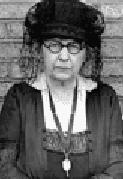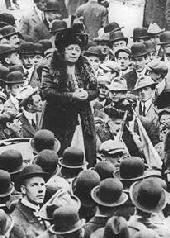
Harriot Stanton Blatch (January 20, 1856-November 20, 1940) was a leader in the woman suffrage movement, a writer and an advocate for labor reform. She is credited with modernizing a suffrage movement that, by the opening of the 20th century, was listless and flagging. Her radical style combined militant civil disobedience with political activism. The combination of her energy, daring and political savvy spurred the movement on to its goal of enfranchising American women with the passage of the Nineteenth Amendment to the Constitution in 1920.
The sixth of seven children of noted suffragist Elizabeth Cady Stanton, Harriot was born “in the very cradle of the feminist movement,” Seneca Falls, New York, site of the first Woman’s Rights Convention of 1848. Raised in a family where every member was expected to have an opinion and to voice it, she was trained from an early date in politics and social activism. Leaders of the day such as Susan B. Anthony, Sojourner Truth, William Lloyd Garrison and Wendell Phillips were family friends who undoubtedly influenced the young Stantons. The two girls of the family, along with their five brothers, were expected to form their own views and take an active role in the world. So successful were the elder Stantons in instilling a model of independence and free-thinking in their children that a cousin complained that “Aunt Lib taught her daughters that they were the chosen few . . . and so must regulate the affairs of the universe.”
After earning a bachelor’s degree at Vassar College, 1878, and spending a year at the Boston School of Oratory, Harriot took to the lecture circuit with her mother. The 1879-80 lyceum lecture tour left Harriot ailing, exhausted and discouraged. Somewhat adrift, she took the advice of William Lloyd Garrison to “seize the first bit of work that offers, if it is honest and honorable,” and left for Europe as tutor to two wealthy American sisters.
In Europe Harriot widened her experience of the world. Although she led an active social life, her diaries show a young woman who stood at an emotional distance from others and recognized that others often saw her as “affected” rather than “amiable.” Harriot was to remain an intensely private person, taking to heart her mother’s admonition to keep public and personal spheres separate. Her published memoirs reveal little of domestic life, concentrating instead on intellectual and professional pursuits.
Although her search for spiritual transcendence remained important throughout her life, it is an area almost wholly absent from her public writings. Young Harriot attended Presbyterian Sunday School until rebelling, around age nine, at being rewarded for memorizing the Shorter Westminster Catechism by having to learn Psalm 18. She felt that this was not “just or seemly” and that she had “better seek instruction in the Christian virtues elsewhere.” After the Stanton family moved to New York City in 1862, Harriot found a home she “thoroughly enjoyed” in the church school of Unitarian Octavius Brooks Frothingham, where the Bible was introduced as “partly the history and partly the myths of a primitive people.”
From her mother Harriot inherited a religion that combined scientific rationality and reform activism. She found this “sacred humanity” view too individualistic, however; hers was a more communal view, seeing society as an integrated whole. Her greatest inspiration and spiritual comfort came from the beauties of nature. Although she never discussed personal religion in her memoirs, the tone with which she described the beauties of the world is unmistakably worshipful. Her European diaries recount her struggle at holding this religion of nature in tension with a passion for scientific investigation that drove her to observe and catalog all things. “When something pleases me deeply I do not want on paper to analyze it minutely,” she wrote. She felt that even the experience of transcendence was something to be studied as she analyzed the “soul impression” made by sun flickering on the trees outside Paris. In her work we see more of her mother’s religion of humanity than of this young woman who drank inspiration from sunlight and mountain peaks.
Summoned home from Europe to help her mother and Susan B. Anthony complete their book, the History of Woman Suffrage, Harriot insisted that a chapter on the American Woman’s Suffrage Association be included along with the story of Stanton and Anthony’s own National Woman’s Suffrage Association. They assigned that chapter to her, and it was a significant contribution, avoiding a slight that would otherwise have caused trouble in the movement.
On the ship bound for New York, Harriot had met an English businessman, William Henry (Harry) Blatch. Despite her worries that “marriage would destroy [her] usefulness,” they were married on November 15, 1882, in the Unitarian Little Portland Street Chapel in London by the Rev. William Henry Channing. Harriot’s mother had wanted the ceremony to be performed jointly by two American Unitarian ministers living in London, Channing, a close friend, and the Rev. Moncure Conway, a radical whose criticisms of Christianity closely paralleled her own. When Channing refused to work with Conway, whom he considered dismissive of the marriage sacrament, Harriot wrote to Conway that Channing’s refusal to cooperate showed “that Dr. Channing is more orthodox than I had supposed.” For Harriot, the sacrament of marriage came not from divine blessing but from “the real aspirations of living men and women.” In a forthright statement of religious belief, she wrote, “On my wedding day of all days, I feel I must be wholly true, and would I be that if I invoked the blessings of a Being in whom I have no belief?” In the end, Elizabeth Stanton had her way, and Channing performed the ceremony.
Harriot and Harry Blatch’s first daughter, Nora, was born in 1883. Channing came to bless and name the child, though Harriot made it quite clear there was to be no formal baptism. As an adult, Nora was to join her mother in her work for woman suffrage.
The Blatches’ second daughter, Helen, never got that opportunity. She died in 1896 just shy of her fourth birthday. Harriot never wrote publicly about Helen’s death, and she is not even mentioned in Harriot’s memoirs.
Harriot Blatch spent the first twenty years of her marriage in Basingstoke, England, where she became involved with the English suffrage movement and Fabian socialism. Harriot protested that by virtue of her marriage she had become a citizen of England without her consent. She always felt like an American in her heart, and forewent swearing allegiance to Queen Victoria, a move that kept her from holding political office. She did, however, hold leadership positions in suffrage societies, the Woman’s Local Government Society, the Women’s Liberal Federation and the Fabian Society. In 1894 she was granted a Master of Arts degree by Vassar for her study of England’s rural poor.

In 1902 Blatch returned to the United States, where her work for women’s rights would reach its greatest heights. Confident that people are moved more by emotion than by logic, she set about revitalizing a movement that “bored its adherents and repelled it opponents.” In January 1907 she became a founder and first president of the Equality League of Self-Supporting Women, later called the Women’s Political Union, and organized a campaign of publicity, education and civil action. Although more conservative suffrage workers were shocked by her tactics, Blatch instituted open-air meetings, spreading the message of enfranchisement on street corners and in parks and, once, even in a cemetery. Starting in 1908 she organized mass meetings at Cooper Union and annual Suffrage Day parades in New York. For the 1912 parade, the New York Tribune reported 20,000 marchers and 80,000 spectators.
Blatch combined these tactics of civil protest with political action. She was determined that only through political channels would the dream of suffrage be realized. Seeing working-class women more as exemplars for others than as “victims to be succored,” Blatch brought working women to Albany to argue their own case. At a 1907 hearing in Albany, union workers spoke so eloquently that an anti-suffrage debater relinquished her rebuttal time saying, “I have been given today much to think about. I am not convinced, but I am silenced.” The New York suffrage amendment of 1915, championed by Blatch, was defeated, but a similar amendment was passed in 1917.
Blatch moved to the national scene. From Grandma Cady, she had “learned to mold people and circumstance” through “secrecy, manipulation, leadership,” all virtues in Blatch’s estimation, and virtues she put to good use. During a visit from suffragist Anne Cobden-Sanderson, well-known in England but unknown in America, Blatch casually informed an immigration official of Mrs. Cobden-Sanderson’s prison record. His efforts to block the well-connected suffragist’s immigration made him an unwitting “Sir Galahad” by creating all the publicity Blatch wanted. During the Republican parade preceding the 1908 election, Blatch stationed the exquisite Inez Milholland in a storefront window along the parade route. Distracted by this striking beauty, the young male marchers broke ranks, and “the young Republicans were persuaded to withdraw and console themselves with suffrage literature.” In another political move Blatch took advantage of voting laws that stated that anyone could be a poll watcher and placed suffragists as watchers in the all-male polling places.
On August 26, 1920, all of Blatch’s manipulations and political maneuvering, humorous and serious, bore fruit in ratification of the Nineteenth Amendment. She now turned her considerable energies elsewhere.
In 1918 her first book, Mobilizing Woman Power, had been a feminist view in favor of war as providing equality of work for women. Thoroughly dismayed by first-hand experience of war-ravaged Europe, she turned to the peace movement. In 1920 she published her second book, A Woman’s Point of View, Some Roads to Peace. She wrote: “My opposition to war was not because of the horrors of war, not because war demands that the race offer up its very best in their full vigor, not because war means economic bankruptcy, domination of races by famine and disease, but because war is so completely ineffective, so stupid. It settles nothing.”
Blatch continued her political work on behalf of workers joining the Socialist Party because it was the only party that “aimed to raise the standard of living of the average citizen.” She advocated motherhood endowments and pensions to create economic independence valuing the work of mothers.
She worked tirelessly to protect the place of her own mother in history. With her brother Theodore, she collected the materials for Elizabeth Cady Stanton: As Revealed in Her Letters, Diary and Reminiscences, 1922. She spent her last decade promoting her mother’s and her own contributions to women’s rights.
Sources
Many of Blatch’s papers are in the Library of Congress. Others can be found in the Rhoda Barney Jenkins Papers, Greenwich, Connecticut and the Moncure Conway Collection, Columbia University, New York City. Blatch’s memoirs, co-written with historian Alma Lutz, were published as Challenging Years (1940). Recent biographical works include Phyllis Eckhaus, “Feminist Foremother.” The Nation (December 29, 1997) and Ellen Carol DuBois, Harriot Stanton Blatch and the Winning or Woman Suffrage (1997) and “Working Women, Class Relations, and Suffrage Militance: Harriot Stanton Blatch and the New York Woman Suffrage Movement, 1894-1909,” in One Woman, One Vote: Rediscovering the Woman Suffrage Movement, ed. Marjorie Spruill Wheeler (1995). There are short entries on Blatch in the Encyclopaedia Britannica and American National Biography.
Article by Jacqueline Clement
Posted June 15, 2002